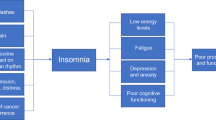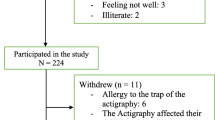Abstract
Purpose
Insomnia is increasingly recognized as a major symptom outcome in breast cancer; however, little is known about its prevalence and risk factors among women receiving aromatase inhibitors (AIs), a standard treatment to increase disease-free survival among breast cancer patients.
Methods
A cross-sectional survey study was conducted among postmenopausal women with stage 0–III breast cancer receiving adjuvant AI therapy at an outpatient breast oncology clinic of a large university hospital. The insomnia severity index (ISI) was used as the primary outcome. Multivariate logistic regression analyses were performed to evaluate risk factors.
Results
Among 413 participants, 130 (31.5 %) had subthreshold insomnia on the ISI, and 77 (18.64 %) exceeded the threshold for clinically significant insomnia. In a multivariate logistic regression model, clinically significant insomnia was independently associated with severe joint pain (adjusted odds ratio (AOR) 4.84, 95 % confidence interval (CI) 1.71–13.69, P = 0.003), mild/moderate hot flashes (AOR 2.28, 95 % CI 1.13–4.60, P = 0.02), severe hot flashes (AOR 2.29, 95 % CI 1.23–6.81, P = 0.015), anxiety (AOR 1.99, 95 % CI 1.08–3.65, P = 0.027), and depression (AOR 3.57, 95 % CI 1.48–8.52, P = 0.004). Age (>65 vs. <55 years; AOR 2.31; 95 % CI 1.11–4.81; P = 0.026) and time since breast cancer diagnosis (<2 vs. 2–5 years; AOR 1.94; 95 % CI 1.02–3.69; P = 0.045) were also found to be significant risk factors. Clinical insomnia was more common among those who used medication for treating insomnia and pain.
Conclusions
Insomnia complaints exceed 50 % among AI users. Clinically significant insomnia is highly associated with joint pain, hot flashes, anxiety and depression, age, and time since diagnosis.

Similar content being viewed by others
References
Savard J, Morin CM (2001) Insomnia in the context of cancer: a review of a neglected problem. J Clin Oncol 19(3):895–908
Simeit R, Deck R, Conta-Marx B (2004) Sleep management training for cancer patients with insomnia. Support Care Cancer 12(3):176–183. doi:10.1007/s00520-004-0594-5
Savard J, Simard S, Blanchet J, Ivers H, Morin CM (2001) Prevalence, clinical characteristics, and risk factors for insomnia in the context of breast cancer. Sleep 24(5):583–590
Fortner BV, Stepanski EJ, Wang SC, Kasprowicz S, Durrence HH (2002) Sleep and quality of life in breast cancer patients. J Pain Symptom Manage 24(5):471–480
Davidson JR, MacLean AW, Brundage MD, Schulze K (2002) Sleep disturbance in cancer patients. Soc Sci Med 54(9):1309–1321
Bardwell WA, Profant J, Casden DR, Dimsdale JE, Ancoli-Israel S, Natarajan L, Rock CL, Pierce JP (2008) The relative importance of specific risk factors for insomnia in women treated for early-stage breast cancer. Psychooncology 17(1):9–18. doi:10.1002/pon.1192
Knobf MT (2006) The influence of endocrine effects of adjuvant therapy on quality of life outcomes in younger breast cancer survivors. Oncologist 11(2):96–110. doi:10.1634/theoncologist.11-2-96
Carpenter JS, Elam JL, Ridner SH, Carney PH, Cherry GJ, Cucullu HL (2004) Sleep, fatigue, and depressive symptoms in breast cancer survivors and matched healthy women experiencing hot flashes. Oncol Nurs Forum 31(3):591–5598. doi:10.1188/04.ONF.591-598
Jakesz R, Jonat W, Gnant M, Mittlboeck M, Greil R, Tausch C, Hilfrich J, Kwasny W, Menzel C, Samonigg H, Seifert M, Gademann G, Kaufmann M, Wolfgang J (2005) Switching of postmenopausal women with endocrine-responsive early breast cancer to anastrozole after 2 years' adjuvant tamoxifen: combined results of ABCSG trial 8 and ARNO 95 trial. Lancet 366(9484):455–462
Goss PE, Ingle JN, Martino S, Robert NJ, Muss HB, Piccart MJ, Castiglione M, Tu D, Shepherd LE, Pritchard KI, Livingston RB, Davidson NE, Norton L, Perez EA, Abrams JS, Therasse P, Palmer MJ, Pater JL (2003) A randomized trial of letrozole in postmenopausal women after five years of tamoxifen therapy for early-stage breast cancer. N Engl J Med 349(19):1793–1802
Howell A, Cuzick J, Baum M, Buzdar A, Dowsett M, Forbes JF, Hoctin-Boes G, Houghton J, Locker GY, Tobias JS (2005) Results of the ATAC (Arimidex, Tamoxifen, Alone or in Combination) trial after completion of 5 years' adjuvant treatment for breast cancer. Lancet 365(9453):60–62
Coombes RC, Hall E, Gibson LJ, Paridaens R, Jassem J, Delozier T, Jones SE, Alvarez I, Bertelli G, Ortmann O, Coates AS, Bajetta E, Dodwell D, Coleman RE, Fallowfield LJ, Mickiewicz E, Andersen J, Lonning PE, Cocconi G, Stewart A, Stuart N, Snowdon CF, Carpentieri M, Massimini G, Bliss JM, van de Velde C (2004) A randomized trial of exemestane after two to three years of tamoxifen therapy in postmenopausal women with primary breast cancer. N Engl J Med 350(11):1081–1092
American Society of Clinical Oncology (2010) ASCO Guideline Update Recommends Aromatase InhibitorsAlone or with Tamoxifen as Adjuvant Therapy for Post-Menopausal Women with Hormone-Receptor Positive Breast Cancer, July 12 2010. Accessed at http://wwwascoorg/ascov2/Press+Center/Latest+News+Releases/ASCO+News/ASCO+Guideline+Update+Recommends+Aromatase+InhibitorsAlone+or+with+Tamoxifen+as+Adjuvant+Therapy+for+Post-Menopausal+Women+with+Hormone-Receptor+Positive+Breast+Cancer on February 22, 2012
Chlebowski RT (2009) Aromatase inhibitor-associated arthralgias. J Clin Oncol 27(30):4932–4934. doi:10.1200/JCO.2009.23.3270
Burstein HJ, Prestrud AA, Seidenfeld J, Anderson H, Buchholz TA, Davidson NE, Gelmon KE, Giordano SH, Hudis CA, Malin J, Mamounas EP, Rowden D, Solky AJ, Sowers MR, Stearns V, Winer EP, Somerfield MR, Griggs JJ (2010) American Society of Clinical Oncology clinical practice guideline: update on adjuvant endocrine therapy for women with hormone receptor-positive breast cancer. J Clin Oncol 28(23):3784–3796. doi:10.1200/JCO.2009.26.3756
Fallowfield L, Cella D, Cuzick J, Francis S, Locker G, Howell A (2004) Quality of life of postmenopausal women in the Arimidex, Tamoxifen, Alone or in Combination (ATAC) Adjuvant Breast Cancer Trial. J Clin Oncol 22(21):4261–4271. doi:10.1200/JCO.2004.08.029
Garreau JR, Delamelena T, Walts D, Karamlou K, Johnson N (2006) Side effects of aromatase inhibitors versus tamoxifen: the patients' perspective. Am J Surg 192(4):496–498. doi:10.1016/j.amjsurg.2006.06.018
Carpenter JS, Andrykowski MA (1999) Menopausal symptoms in breast cancer survivors. Oncol Nurs Forum 26(8):1311–1317
Carpenter JS, Andrykowski MA, Cordova M, Cunningham L, Studts J, McGrath P, Kenady D, Sloan D, Munn R (1998) Hot flashes in postmenopausal women treated for breast carcinoma: prevalence, severity, correlates, management, and relation to quality of life. Cancer 82(9):1682–1691. doi:10.1002/(SICI)1097-0142(19980501)82:9<1682::AID-CNCR14>3.0.CO;2-0
Couzi RJ, Helzlsouer KJ, Fetting JH (1995) Prevalence of menopausal symptoms among women with a history of breast cancer and attitudes toward estrogen replacement therapy. J Clin Oncol 13(11):2737–2744
Geisler J, Lonning PE (2010) Impact of aromatase inhibitors on bone health in breast cancer patients. J Steroid Biochem Mol Biol 118(4–5):294–299. doi:10.1016/j.jsbmb.2009.10.004
Su HI, Sammel MD, Springer E, Freeman EW, DeMichele A, Mao JJ (2010) Weight gain is associated with increased risk of hot flashes in breast cancer survivors on aromatase inhibitors. Breast Cancer Res Treat 124(1):205–211. doi:10.1007/s10549-010-0802-6
Mao JJ, Su HI, Feng R, Donelson ML, Aplenc R, Rebbeck TR, Stanczyk F, Demichele A (2011) Association of functional polymorphisms in CYP19A1 with aromatase inhibitor associated arthralgia in breast cancer survivors. Breast Cancer Res 13(1):R8. doi:10.1186/bcr2813
Mao JJ, Stricker C, Bruner D, Xie S, Bowman MA, Farrar JT, Greene BT, DeMichele A (2009) Patterns and risk factors associated with aromatase inhibitor-related arthralgia among breast cancer survivors. Cancer 115(16):3631–3639. doi:10.1002/cncr.24419
Savard J, Davidson JR, Ivers H, Quesnel C, Rioux D, Dupere V, Lasnier M, Simard S, Morin CM (2004) The association between nocturnal hot flashes and sleep in breast cancer survivors. J Pain Symptom Manage 27(6):513–522. doi:10.1016/j.jpainsymman.2003.10.013
Koopman C, Nouriani B, Erickson V, Anupindi R, Butler LD, Bachmann MH, Sephton SE, Spiegel D (2002) Sleep disturbances in women with metastatic breast cancer. Breast J 8(6):362–370
Bastien CH, Vallieres A, Morin CM (2001) Validation of the Insomnia Severity Index as an outcome measure for insomnia research. Sleep Med 2(4):297–307
Savard MH, Savard J, Simard S, Ivers H (2005) Empirical validation of the Insomnia Severity Index in cancer patients. Psychooncology 14(6):429–441. doi:10.1002/pon.860
Carroll BT, Kathol RG, Noyes R Jr, Wald TG, Clamon GH (1993) Screening for depression and anxiety in cancer patients using the Hospital Anxiety and Depression Scale. Gen Hosp Psychiatry 15(2):69–74
Smith AB, Selby PJ, Velikova G, Stark D, Wright EP, Gould A, Cull A (2002) Factor analysis of the Hospital Anxiety and Depression Scale from a large cancer population. Psychol Psychother 75(Pt 2):165–176
Mykletun A, Stordal E, Dahl AA (2001) Hospital Anxiety and Depression (HAD) scale: factor structure, item analyses and internal consistency in a large population. Br J Psychiatry 179:540–544
Ancoli-Israel S, Liu L, Marler MR, Parker BA, Jones V, Sadler GR, Dimsdale J, Cohen-Zion M, Fiorentino L (2006) Fatigue, sleep, and circadian rhythms prior to chemotherapy for breast cancer. Support Care Cancer 14(3):201–209. doi:10.1007/s00520-005-0861-0
Yang CM, Spielman AJ, Glovinsky P (2006) Nonpharmacologic strategies in the management of insomnia. Psychiatr Clin North Am 29(4):895–919. doi:10.1016/j.psc.2006.09.005, abstract viii
Ebben MR, Spielman AJ (2009) Non-pharmacological treatments for insomnia. J Behav Med 32(3):244–254. doi:10.1007/s10865-008-9198-8
Taylor LM, Espie CA, White CA (2003) Attentional bias in people with acute versus persistent insomnia secondary to cancer. Behav Sleep Med 1(4):200–212
Bixler EO, Vgontzas AN, Lin HM, Ten Have T, Rein J, Vela-Bueno A, Kales A (2001) Prevalence of sleep-disordered breathing in women: effects of gender. Am J Respir Crit Care Med 163(3 Pt 1):608–613
Young T, Rabago D, Zgierska A, Austin D, Laurel F (2003) Objective and subjective sleep quality in premenopausal, perimenopausal, and postmenopausal women in the Wisconsin Sleep Cohort Study. Sleep 26(6):667–672
Acknowledgments
We would like to thank all the breast cancer survivors, physicians, nurse practitioners, and staff for their support. We would like to thank all the work study students for their dedication to the data collection and management process. Funding support was received from the Penn Clinical Pharmacogenomic Epidemiology Pilot Grant National Institutes of Health (NIH) 5P20RR020741, Penn Institute of Aging Pilot Grant, and NIH AT004695. Dr. Mao is supported by the American Cancer Society CCCDA-08-107-01 and NIH K23 AT004112.
Conflict of interest
None
Author information
Authors and Affiliations
Corresponding author
Rights and permissions
About this article
Cite this article
Desai, K., Mao, J.J., Su, I. et al. Prevalence and risk factors for insomnia among breast cancer patients on aromatase inhibitors. Support Care Cancer 21, 43–51 (2013). https://doi.org/10.1007/s00520-012-1490-z
Received:
Accepted:
Published:
Issue Date:
DOI: https://doi.org/10.1007/s00520-012-1490-z




